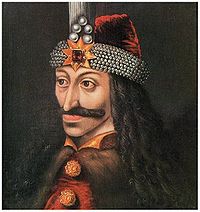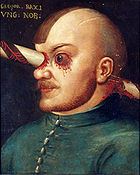
Chamber of Art and Curiosities
Encyclopedia
The Chamber of Art and Curiosities is a cabinet of curiosities
created by Ferdinand II, Archduke of Austria
in the 16th century. Representing an excellent example of a late Renaissance
encyclopedic collection of its genre, it continues to be displayed at Ambras Castle
near Innsbruck
, the same setting since its inception. Ferdinand II, like many other rulers of the Renaissance, was interested in promoting the arts and sciences. He spent considerable time and money on his unique collection and converted the medieval Ambras Castle into a contemporary palace to display his possessions. Beside the chamber of arts and curiosities the castle is home to a collection of medieval weapons and the "Habsburg Portrait Gallery". The collection also contains paintings by Hans von Aachen
. Today, these collections at Ambras are administered by the Kunsthistorisches Museum
, Vienna
.
collections and artifacts, glass figures, centerpieces, mechanical toys, clocks and various instruments. Also, Asiatica of the period are included with a suit of samurai
armor, a Ryukyu bowl, and a silk painting from China.

's depiction was painted about one century after his reign and represents one of his earliest portraits. It is intended not only to show him as a ruler but also to be a "psychogram of evil".
, also called Ambras syndrome in 1933 in reference to its depiction at this collection. The life of Pedro Gonzalez has been well chronicled as he became famous during his lifetime on account of his condition. Born in 1537 in Tenerife
, he first came to the court of Henry II, King of France
, who sent him to the court of Margaret of Parma
, regent of the Netherlands. He got married there and some of his children were also afflicted with hypertrichosis universalis and painted. His family became an object of medical inquiry by Ulisse Aldrovandi
among others. Gonzalez eventually settled in Italy.
 This portrait represents a Hungarian hussar
This portrait represents a Hungarian hussar
, by tradition Gregor Baci, who apparently survived a piercing injury with a lance to the right side of his face. The injury may have occurred during a jousting tournament or while fighting the Ottoman Turks. The painting was created by an unknown artist in the 16th century and first listed in 1622.
Cabinet of curiosities
A cabinet of curiosities was an encyclopedic collection in Renaissance Europe of types of objects whose categorical boundaries were yet to be defined. They were also known by various names such as Cabinet of Wonder, and in German Kunstkammer or Wunderkammer...
created by Ferdinand II, Archduke of Austria
Ferdinand II, Archduke of Austria
Ferdinand II, Archduke of Further Austria was ruler of Further Austria including Tirol.-Life account:...
in the 16th century. Representing an excellent example of a late Renaissance
Renaissance
The Renaissance was a cultural movement that spanned roughly the 14th to the 17th century, beginning in Italy in the Late Middle Ages and later spreading to the rest of Europe. The term is also used more loosely to refer to the historical era, but since the changes of the Renaissance were not...
encyclopedic collection of its genre, it continues to be displayed at Ambras Castle
Ambras Castle
Ambras Castle is a schloss in Innsbruck, Austria. Situated in the hills above Innsbruck, the Castle of Ambras is one of the most important sights of the city...
near Innsbruck
Innsbruck
- Main sights :- Buildings :*Golden Roof*Kaiserliche Hofburg *Hofkirche with the cenotaph of Maximilian I, Holy Roman Emperor*Altes Landhaus...
, the same setting since its inception. Ferdinand II, like many other rulers of the Renaissance, was interested in promoting the arts and sciences. He spent considerable time and money on his unique collection and converted the medieval Ambras Castle into a contemporary palace to display his possessions. Beside the chamber of arts and curiosities the castle is home to a collection of medieval weapons and the "Habsburg Portrait Gallery". The collection also contains paintings by Hans von Aachen
Hans von Aachen
Hans von Aachen , was a German mannerist painter.-Biography:He was born in Cologne, but his name is derived from the birthplace of his father, Aachen in Germany...
. Today, these collections at Ambras are administered by the Kunsthistorisches Museum
Kunsthistorisches Museum
The Kunsthistorisches Museum is an art museum in Vienna, Austria. Housed in its festive palatial building on Ringstraße, it is crowned with an octagonal dome...
, Vienna
Vienna
Vienna is the capital and largest city of the Republic of Austria and one of the nine states of Austria. Vienna is Austria's primary city, with a population of about 1.723 million , and is by far the largest city in Austria, as well as its cultural, economic, and political centre...
.
The Collection
A variety of uncommon objects are on display, including a woodcarving of "Death as a Hunter" by Hans Leiberger, goblets, coralCoral
Corals are marine animals in class Anthozoa of phylum Cnidaria typically living in compact colonies of many identical individual "polyps". The group includes the important reef builders that inhabit tropical oceans and secrete calcium carbonate to form a hard skeleton.A coral "head" is a colony of...
collections and artifacts, glass figures, centerpieces, mechanical toys, clocks and various instruments. Also, Asiatica of the period are included with a suit of samurai
Samurai
is the term for the military nobility of pre-industrial Japan. According to translator William Scott Wilson: "In Chinese, the character 侍 was originally a verb meaning to wait upon or accompany a person in the upper ranks of society, and this is also true of the original term in Japanese, saburau...
armor, a Ryukyu bowl, and a silk painting from China.

Paintings
The Ambras collection contains a number of unique portraits, and some of the subjects were perceived at the time as miracles of nature. The painters are not known. Giants and dwarfs, people with hirsutism and others, are shown, including:Vlad Ţepeş
Vlad III the ImpalerVlad III the Impaler
Vlad III, Prince of Wallachia , also known by his patronymic Dracula , and posthumously dubbed Vlad the Impaler , was a three-time Voivode of Wallachia, ruling mainly from 1456 to 1462, the period of the incipient Ottoman conquest of the Balkans...
's depiction was painted about one century after his reign and represents one of his earliest portraits. It is intended not only to show him as a ruler but also to be a "psychogram of evil".
Petrus Gonsalvus
The collection has a painting of Pedro Gonzalez (Petrus Gonsalvus) as well as other people who display an extreme form of hirsutismHirsutism
Hirsutism or frazonism is the excessive hairiness on women in those parts of the body where terminal hair does not normally occur or is minimal - for example, a beard or chest hair. It refers to a male pattern of body hair and it is therefore primarily of cosmetic and psychological concern...
, also called Ambras syndrome in 1933 in reference to its depiction at this collection. The life of Pedro Gonzalez has been well chronicled as he became famous during his lifetime on account of his condition. Born in 1537 in Tenerife
Tenerife
Tenerife is the largest and most populous island of the seven Canary Islands, it is also the most populated island of Spain, with a land area of 2,034.38 km² and 906,854 inhabitants, 43% of the total population of the Canary Islands. About five million tourists visit Tenerife each year, the...
, he first came to the court of Henry II, King of France
Henry II of France
Henry II was King of France from 31 March 1547 until his death in 1559.-Early years:Henry was born in the royal Château de Saint-Germain-en-Laye, near Paris, the son of Francis I and Claude, Duchess of Brittany .His father was captured at the Battle of Pavia in 1525 by his sworn enemy,...
, who sent him to the court of Margaret of Parma
Margaret of Parma
Margaret, Duchess of Parma , Governor of the Netherlands from 1559 to 1567 and from 1578 to 1582, was the illegitimate daughter of Charles V and Johanna Maria van der Gheynst...
, regent of the Netherlands. He got married there and some of his children were also afflicted with hypertrichosis universalis and painted. His family became an object of medical inquiry by Ulisse Aldrovandi
Ulisse Aldrovandi
Ulisse Aldrovandi was an Italian naturalist, the moving force behind Bologna's botanical garden, one of the first in Europe. Carolus Linnaeus and the comte de Buffon reckoned him the father of natural history studies...
among others. Gonzalez eventually settled in Italy.
A man with disabilities
This is an unusual and unique late 16th-century painting of a man with a physical disability. In typical portrait-style he gazes at the viewer, while the top of his head is covered by a hat. A fashionable neck piece separates his head from his naked body, which lies chest-down on a dark green sheet. His limbs appear withered and useless. Originally the portrait was partially obscured by a sheet of red paper, which the observer would lift to reveal the subject's body. Observers indicated that they were shocked. The man was probably a jester at a court. An extensive analysis of the painting has been published (see external links).Gregor Baci

Hussar
Hussar refers to a number of types of light cavalry which originated in Hungary in the 14th century, tracing its roots from Serbian medieval cavalry tradition, brought to Hungary in the course of the Serb migrations, which began in the late 14th century....
, by tradition Gregor Baci, who apparently survived a piercing injury with a lance to the right side of his face. The injury may have occurred during a jousting tournament or while fighting the Ottoman Turks. The painting was created by an unknown artist in the 16th century and first listed in 1622.

